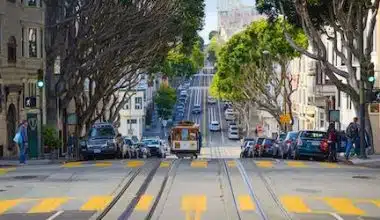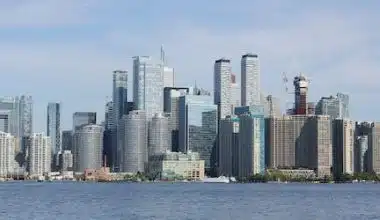Explore the diverse urban landscape of North Carolina and discover the state’s largest cities that blend history, culture, and modernity into a vibrant atmosphere. North Carolina’s largest cities are Charlotte, Raleigh, Greensboro, and Durham, among others listed in this article, including the benefits and downsides you might encounter. Charlotte is the state’s financial and cultural hub, while Raleigh is the state capital and the second-biggest city. Greensboro is known for its oak trees and major research universities. Durham is the second-largest city in the Research Triangle region and is known for its arts and culture scene.
Largest Cities In North Carolina
The largest cities in North Carolina have their unique character and attractions, from the financial and cultural hub of Charlotte to the historic downtown area of Wilmington.
#1. Charlotte
With a population of 879,709, Charlotte is the largest city in North Carolina by population. It is located in Mecklenburg County and is also the state’s main financial and cultural hub. Charlotte is the second-largest banking sector in the country and home to the headquarters of Bank of America and Trust Financial.
#2. Raleigh
Raleigh is the state capital and the second-biggest city in North Carolina by population, with 476,587 residents. It is known as “the City of Oaks” and is famous for its gorgeous Oak trees that line the city streets. It is also the largest city in the Research Triangle region of Piedmont County, an area home to three major research universities: North Carolina State University, Duke University, and the University of North Carolina.
#3. Greensboro
With a population of 301,115, Greensboro is one of the largest cities in North Carolina and the largest in the Piedmont Triad metropolitan region, which also includes nearby cities of Winston-Salem and High Point. The city has many notable attractions, including the Greensboro Science Center, the Weatherspoon Art Museum, and the International Civil Rights Museum.
#4. Durham
Durham is another one of the major cities in North Carolina, 291,928 people are living there. It is the second largest city in the Research Triangle region and is home to Duke University and North Carolina Central University. Durham is also known for its vibrant arts and culture scene, with many museums, galleries, and theaters.
#5. Winston-Salem
Winston-Salem has a population of 248,112 and is the fifth-largest city in North Carolina. It is located in Forsyth County and is known for its rich history and cultural heritage. The city is home to many museums, including the Reynolda House Museum of American Art and the Southeastern Center for Contemporary Art.
#6. Fayetteville
Fayetteville residents are 208,501 and are located in Cumberland County. It is home to Fort Bragg, one of the largest military installations in the world. The city is also known for its historic downtown area and many parks and outdoor recreation areas.
#7. Cary
Cary has a population of 170,282 and is located in Wake County. It is known for its high quality of life, excellent schools, and many parks and green spaces. The city is also home to many technology companies and research institutions.
#8. Wilmington
Wilmington has a population of 114,059 and is located in New Hanover County. It is known for its beautiful beaches, historic downtown area, and many cultural attractions. The city is also home to EUE Screen Gems Studios, the largest domestic television and film production facility outside of California.
#9. High Point
High Point has a population of 111,714 and is located in Guilford County. It is known as the “Furniture Capital of the World” and is home to many furniture manufacturers and showrooms. The city is also known for its many parks and outdoor recreation areas.
#10. Concord
Concord has a population of 98,078 and is located in Cabarrus County. It is known for its many shopping and entertainment options, including the Concord Mills Mall and the Charlotte Motor Speedway. The city is also home to many parks and outdoor recreation areas.
Benefits of Staying in the Largest Cities in North Carolina
#1. Job Opportunities
The largest cities in North Carolina, such as Charlotte and Raleigh, offer a wide range of job opportunities across various industries, including banking, finance, technology, healthcare, and more.
#2. Economic Growth
These cities are experiencing significant economic growth, attracting businesses and creating a favorable environment for career advancement and entrepreneurship.
#3. Cultural and Entertainment Options
The largest cities in North Carolina have a vibrant arts and culture scene, with museums, theaters, music venues, and festivals. Residents can enjoy a variety of cultural experiences and entertainment options.
#4. Outdoor Recreation
North Carolina’s largest cities are surrounded by natural beauty, offering opportunities for outdoor activities. From hiking trails and parks to lakes and beaches, residents can enjoy a wide range of recreational activities.
#5. Educational Institutions
The largest cities in North Carolina are home to prestigious universities and colleges, providing access to quality education and research opportunities.
#6. Healthcare Facilities
These cities have well-established healthcare systems, with access to top-notch medical facilities and specialized healthcare services.
#7. Diverse Dining and Cuisine
The largest cities in North Carolina offer a diverse culinary scene, with a wide range of restaurants and eateries serving various cuisines. Residents can explore different flavors and enjoy local delicacies.
#8. Sports and Recreation
North Carolina’s largest cities are home to professional sports teams, providing opportunities for sports enthusiasts to attend games and support their favorite teams.
The largest cities in North Carolina provide a diverse and inclusive community, offering opportunities for networking, socializing, and building connections with people from different backgrounds.
#10. Infrastructure and Amenities
These cities have well-developed infrastructure, including transportation systems, shopping centers, recreational facilities, and public services, ensuring convenience and accessibility for residents.
Downsides To Staying In The Largest Cities In North Carolina
#1. Cost of Living
The cost of living in the largest cities, such as Charlotte and Raleigh, can be relatively higher compared to smaller towns or rural areas in the state. Housing, transportation, and certain amenities may come at a higher price.
#2. Traffic Congestion
As urban centers, the largest cities in North Carolina can experience heavy traffic congestion, especially during peak commuting hours. This can lead to longer commute times and increased stress for residents.
#3. Crowded Public Spaces
The popularity and growth of these cities can result in crowded public spaces, including parks, shopping areas, and entertainment venues. This may limit the sense of personal space and tranquility for some individuals.
#4. Environmental Impact
Rapid urbanization and population growth can have environmental consequences, such as increased pollution levels and strain on natural resources. Efforts are being made to address these issues, but they can still be a concern in larger cities.
#5. Competition for Jobs
While larger cities offer more job opportunities, they also attract a larger pool of job seekers. This can lead to increased competition for employment, making it more challenging for individuals to secure desired positions.
#6. Higher Crime Rates
In some cases, larger cities may have higher crime rates compared to smaller towns or rural areas. It’s important to research specific neighborhoods and take necessary precautions to ensure personal safety.
#7. Limited Space and Housing Options
The availability of affordable housing and space can be limited in larger cities, especially in desirable neighborhoods. This can make it more challenging to find suitable housing options, particularly for individuals or families with specific needs or preferences.
#8. Noise and Urbanization
Urban areas tend to be more bustling and noisy compared to quieter rural areas. Some individuals may find the constant activity and noise levels in larger cities overwhelming or disruptive to their preferred lifestyle.
#9. Competition for Resources
The larger cities attract a larger population, which can lead to increased competition for resources such as housing, jobs, and educational opportunities. This can make it more challenging for individuals to secure desired resources.
#10. Limited Sense of Community
While larger cities offer a diverse and vibrant community, some individuals may find it more challenging to establish a close-knit sense of community compared to smaller towns. The fast-paced nature of urban life can make it harder to build deep connections with neighbors and acquaintances.
Tips For Safety In The Largest Cities In North Carolina
#1. Be Aware of Your Surroundings
Stay alert and aware of your surroundings, especially in crowded areas or unfamiliar neighborhoods.
#2. Secure Your Home
Take measures to secure your home, such as installing sturdy locks, using a security system, and keeping doors and windows locked.
#3. Practice Pedestrian Safety
When walking or crossing the street, follow traffic rules, use designated crosswalks, and be cautious of vehicles. The National Highway Traffic Safety Administration (NHTSA) provides resources on pedestrian safety.
#4. Stay Informed
Stay updated on weather alerts and emergency notifications. Consider using apps or services that provide severe weather alerts, such as the American Red Cross app.
#5. Get Involved in Community Watch Programs
Consider participating in community watch programs or neighborhood associations to enhance safety and build a sense of community. Contact your local law enforcement agency for more information.
#6. Report Suspicious Activities
If you witness any suspicious activities or feel unsafe, report them to the appropriate authorities. In cases of emergencies, dial the emergency hotline (911) immediately.
#7. Secure Your Vehicle
Lock your car doors, park in well-lit areas, and avoid leaving valuable items visible inside your vehicle.
#8. Use Public Transportation Safely
If using public transportation, be aware of your surroundings, keep personal belongings secure, and wait for transit in well-lit areas.
#9. Be Cautious in Crowded Areas
Exercise caution in crowded areas, such as downtown or during major events, by keeping personal belongings secure and being aware of your surroundings.
#10. Utilize Safety Apps
Consider using safety apps that provide features like emergency alerts, location sharing, and virtual escorts.
Which Cities are in North Carolina?
Cities in North Carolina are Charlotte, Raleigh, Greensboro, Durham, Winston-Salem, Fayetteville, Cary, Wilmington, High Point, Morehead City, New Bern, Rocky Mount, Laurinburg, Goldsboro and Concord. Each city offers unique amenities, job opportunities, cultural attractions, and recreational activities. The state has approximately 760 municipalities spread across its 100 counties.
Is Charlotte NC A Big City?
Yes, Charlotte, NC is considered a big city. It is the largest city in North Carolina and one of the fastest-growing cities in the United States. Charlotte is known for its thriving economy, diverse population, and vibrant cultural scene. It is the largest city in North Carolina and has hosted major events such as the Democratic National Convention in 2012 and the Republican. The city has a bustling downtown area, a range of amenities, and a strong business presence, particularly in the banking and finance sectors. Charlotte offers a mix of urban attractions, including museums, theaters, sports venues, shopping centers, and a diverse culinary scene. It is also home to several universities and colleges, contributing to its educational and research opportunities.
Is Raleigh NC, a Big City?
Yes, Raleigh, NC is considered a big city. While opinions may vary on what constitutes a big city, Raleigh is generally regarded as a mid-size to large city with significant influence and a growing urban area. It is the capital of North Carolina and the second-largest city in the state, after Charlotte. It is part of the Research Triangle Region, which includes the neighboring cities of Durham and Chapel Hill. This area is known for its thriving economy, research institutions, and educational opportunities. The city itself has a diverse population, a vibrant downtown area, and a range of amenities and cultural attractions.
What Are the 3 Major Cities in North Carolina?
North Carolina’s three major cities are Charlotte, Raleigh, and Greensboro. Charlotte is the largest city with a population of 897,720 and is known for its thriving economy, professional sports teams, and diverse economy. Raleigh is the capital and second-largest city, known for its research institutions and diverse economy. Greensboro, the third-largest city, is known for its arts scene, historical sites, and diverse economy. These cities offer a variety of amenities, job opportunities, and attractions.
What Is the Most Common City in North Carolina?
The most common city in North Carolina is Charlotte. Charlotte is the largest city in North Carolina and has a population of approximately 897,720 people as of 2022. It is known for its thriving economy, diverse population, and vibrant cultural scene. Charlotte is also recognized as a fast-growing metropolitan area and serves as a major banking center in the United States.
Conclusion
The largest cities in North Carolina offer numerous benefits and provide a favorable environment for career advancement and entrepreneurship. These cities can offer higher living costs, traffic congestion, crowded public spaces, environmental impact, job competition, higher crime rates, limited space and housing options, noise and urbanization, competition for resources, and a limited sense of community compared to smaller towns or rural areas. These factors can impact residents’ quality of life, job opportunities, and overall quality of life.
- LIST OF THE CITIES IN UPSTATE NEW YORK
- CLEANEST CITIES IN THE US
- BEST CITIES FOR YOUNG PROFESSIONALS
- THE ULTIMATE LIST OF COLOMBIA CITIES
- ICONIC CITIES NEAR LOS ANGELES






